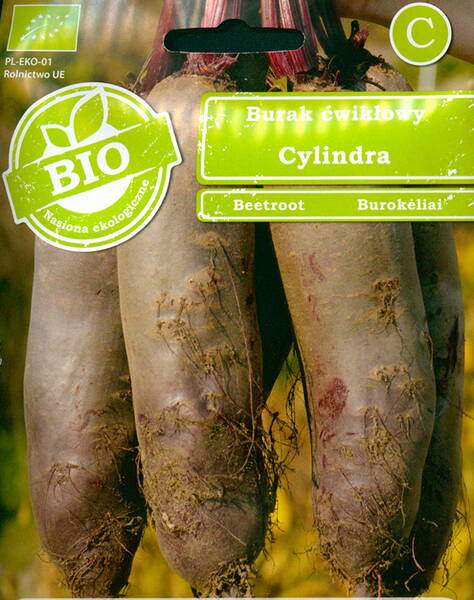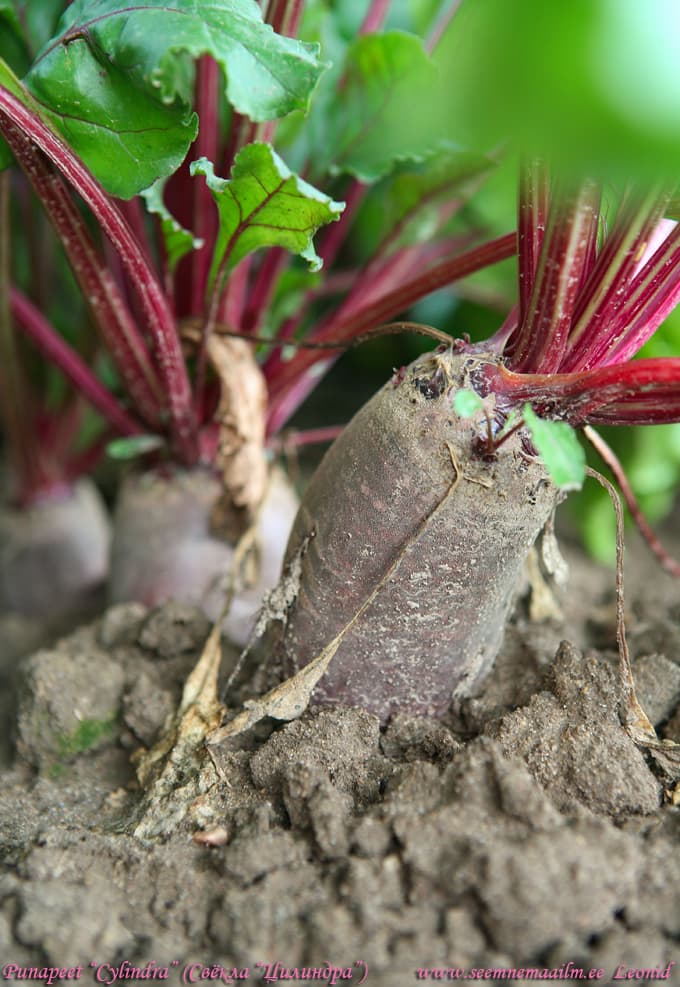Saves crop area + easy harvesting. Reliable and popular variety.
The variety is mid-season: period from germination to harvesting of roots is 110-130 days.
The variety is high-yielding, transportable, well kept. Differs in high resistance to diseases.
Root crops are cylindrical, dark red, 10-16 cm long, 5-9 cm in diameter, weighing 180-350 g with a small pointed tip and smooth skin, which are easily pulled out of the soil.
The pulp of the root vegetable is dark red, without rings, sweet, of high taste. The skin is thin.
Root crops are immersed in the soil for 1 / 3-1 / 4 of the length. Productivity: 7-9 kg / m2.
Used for long-term storage and preservation.
Growing conditions.
Seeds are soaked in water for a day before sowing. The seeding depth, depending on the type of soil, is 2-4 cm. Placed on loose, deeply cultivated soils. Thinning in the phase of 2-3 true leaves.
In spring, beet seeds are sown when the soil warms up to + 8 + 10 ° C.
The sowing depth is 2 cm, the distance between the rows is 30-40 cm, while maintaining (after thinning) the distance between the plants is 10-15 cm.
To obtain an early harvest in our cold climatic zone, it is possible to carry out winter crops.
* When planting beets, remember that this culture loves regular table salt. During growth, it needs to be fed twice with a solution of sodium chloride (1 tbsp. Spoon per 1 bucket of water, calculation per 1 m2 of garden area). You can also apply dry dressing, followed by abundant watering, so that nutrients quickly get into the root growth zone. And so that the beets do not grow in bunches, the seedlings must be thinned out or cut open, that is, transplanted one at a time, be sure to pinch the main root.
If the seedlings are planted too deep when diving, then the root crops will turn out to be small (i.e., it is necessary to plant shallowly - without deepening the neck of the root crop).
And one more trick: beets are very demanding for watering (it is especially important to provide them with moisture in August, at this time there is an intensive filling of their root crops).
* Harvesting and storage of beets.
More sugar accumulates in root vegetables during dry, sunny autumn, when the nights are cooler. Closer to harvesting, watering is stopped, which leads to an intense accumulation of sugar (but if the autumn is very dry, then a week before harvesting the plants need to be watered to avoid the root crops withering).
Harvesting is done in such a way as to prevent them from freezing (this is especially dangerous for varieties with cylindrical roots).
In Estonia, beets are harvested, depending on the weather (in the third decade of September and earlier). To improve storage conditions, it is recommended to roll beets in a cellar with sand, alternating layers of sand with root crops. The temperature should not drop below zero.
Important: when harvesting, do not cut the leaves too close to the root crop - leave three to six centimeters so that the juice does not flow out.
* Signs of nitrogen starvation of plants are slow development, stunted growth, pale green leaves.
With a lack of phosphorus, growth stops and the formation of a root crop is delayed, the leaves become smaller.
A lack of potassium is indicated by a slowdown in growth, the appearance of spotty browning on the leaves, and dying off from the top and edges of plants.
With a lack of manganese, black spots are observed on the leaves (mistaken for a disease), then the leaf blade dies off and twists.
Lack of copper (on peat soils) causes root decay.
Boron reduces dry rot damage to root crops.
Top dressing with a 1% solution of sodium chloride increases the sugar content of root crops: the first top dressing is carried out when a couple of leaves appear with a mullein, diluted 4-5 times or 8-10 times with bird droppings, and the second - after 2-3 weeks with a solution of wood ash (based on 500 g per 10 liters of water).













